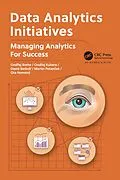The categorisation of analytical projects could help to simplify complexity reasonably and, at the same time, clarify the critical aspects of analytical initiatives. But how can this complex work be categorized? What makes it so complex?
Data Analytics Initiatives: Managing Analytics for Success emphasizes that each analytics project is different. At the same time, analytics projects have many common aspects, and these features make them unique compared to other projects. Describing these commonalities helps to develop a conceptual understanding of analytical work. However, features specific to each initiative affects the entire analytics project lifecycle. Neglecting them by trying to use general approaches without tailoring them to each project can lead to failure.
In addition to examining typical characteristics of the analytics project and how to categorise them, the book looks at specific types of projects, provides a high-level assessment of their characteristics from a risk perspective, and comments on the most common problems or challenges. The book also presents examples of questions that could be asked of relevant people to analyse an analytics project. These questions help to position properly the project and to find commonalities and general project challenges.
Autorentext
Ondrej Bothe has spent his whole life working in the analytical area. He has worked in many different roles: from hands-on developer to manager leading a team responsible for project implementation and IT analytical landscape operation.
Ondrej Kubera has worked more than 10 years in IT delivery and consulting, with a focus on analytics, including areas such as business intelligence, information management, and data governance.
David Bednár loves data and its presentation. In his more than 14 years of experience from both the academic and the business spheres, he is someone who still likes to code something new, who can define architecture and patterns, or support team members around him.
Martin Potancok studied Applied Informatics at the Prague University of Economics and Business. He has more than 12 years of experience in software development and analytics.
Ota Novotný has more than 20 years of practical experience in data and business analytics. He helps people understand the importance and principles of data analytics in both academic and business projects and shows them how to use it in their professional lives.
Klappentext
The three-axis approach to analytics projects
The categorisation of analytical initiatives could help us leverage the knowledge we have already gained and reflect it in our work. Correctly defined categories could help us to simplify the complexity reasonably and, at the same time, understand the critical aspects of analytical work. But how can we do it, and what can make it so complex?
Common attributes of analytics projects
Throughout the book, we reiterate that each analytics project is different. At the same time, analytics projects have a lot in common, and these features make them unique compared to other projects. Describing these commonalities could move us further in the conceptual understanding of analytical work. These specific features impact the entire project lifecycle, and neglecting them (trying to use general approaches without tailoring them to analytics projects) can lead to failure.
General ideas of risks and challenges
Challenges and risks - another critical aspect of analytical initiatives that could be the same from the overall definition perspective, but the realisation and mitigation could significantly differ based on the previously described project categorisation.
Typical failures and risks per project types
To provide a more tangible point of view, we would like to look at things from the opposite angle. So far, we have been looking at the typical characteristics of the analytics project (and how to categorise them). We will look at specific types of projects, provide a high-level assessment of their characteristics from a risk perspective (highly generalised), and comment on the most common problems or challenges.
Typical questions for analytics projects
As the last chapter of the book, we will try to provide you with some examples of questions that could be asked of relevant people in order to analyse the project. These questions may help you properly pos5ition the project on to each axis and understand the commonalities and general project challenges. This serves only as an example and may differ a great deal based on your company and environment.
Inhalt
Foreword
About the Authors
Introduction
The analytics project paradox
Our approach
The focus of the book
The structure of the book
Target audience
Part one - The Framework Definition
1 The three-axis approach to analytics projects
Part two - The Framework in Context
2 Common attributes of analytics projects
3 General areas of risks and challenges
4 Typical failures and risks per project types
5 Typical questions for analytics projects
Conclusion
Index
